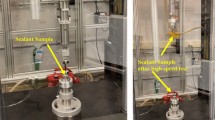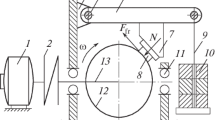Abstract
Elastomeric seals are devices that are widely used to prevent fluid leakage through the interface of a variety of mating industrial components. Gas leak through these seals involves gas flow through the interface of the seal and its corresponding mating component. This flow is understood to initiate due to separation of the surfaces at the sealing interface due to gas pressure. Modelling this separation can aid in optimizing seal designs and in estimating seal failure. In this paper, we develop a simple wedge penetration-based model to describe the separation. The frame work of the model is generic so that it can represent gradual as well as complete seal failures. We illustrate the applicability of this model for elastomer–metal interfaces which involve gradual separation. Nitrogen gas leak rate experimental data for stainless steel with three different elastomers are described using the model. We further discuss the processes and challenges involved in employing this model to estimate leak rate of gas through elastomeric seals of different geometries.
Similar content being viewed by others
References
Druecke, B., Dussan V, E.B., Wicks, N., Hosoi, A.E.: Large elastic deformation as a mechanism for soft seal leakage. J. Appl. Phys. 117(10), 104511 (2015)
Weitzel, D.H., Robbins, R.F., Bopp, G.R., Bjorklund, W.R.: Low temperature static seals using elastomers and plastics. Rev. Sci. Instrum. 31(12), 1350–1351 (1960)
Ito, M., Noguchi, T., Ueki, H., Takeuchi, K., Endo, M.: Carbon nanotube enables quantum leap in oil recovery. Mater. Res. Bull. 46(9), 1480–1484 (2011)
Persson, B.N.J., Yang, C.: Theory of the leak-rate of seals. J. Phys. Condens. Matter. 20(31), 315011 (2008)
Ma, B., Jin, F., Sun, Z., Guo, X.: Leakage analysis of bolted flange joints considering surface roughness: a theoretical model. Proc. Inst. Mech. Eng. Part E J. Process Mech. Eng. 232(2), 203–233 (2018)
Bottiglione, F., Carbone, G., Mangialardi, L., Mantriota, G.: Leakage mechanism in flat seals. J. Appl. Phys. 106(10), 104902 (2009)
Zhang, F., Liu, J., Ding, X., Yang, Z.: An approach to calculate leak channels and leak rates between metallic sealing surfaces. J. Tribol. 139(1), 011708 (2017)
Polycarpou, A.A., Etsion, I.: A model for the static sealing performance of compliant metallic gas seals including surface roughness and rarefaction effects. Tribol. Trans. 43(2), 237–244 (2000)
Jolly, P., Marchand, L.: Leakage predictions for static gasket based on the porous media theory. In: ASME 2006 Pressure Vessels and Piping/ICPVT-11 Conference, pp. 151–158. American Society of Mechanical Engineers (2006)
Sudhamsu, K.S.K., Rao, C.L., Deshpande, A.P., Devan, J.: Experimental characterisation of leak through elastomer-metal interface. Int. J. Mater. Struct. Integr. 13(1–3), 186–199 (2019)
Martinez-Torres, L.M., Ramon-Lluch, R., Eguiluz, L.: Tectonic wedges: geometry and kinematic interpretation. J. Struct. Geol. 16(10), 1491–1494 (1994)
Erdogan, F., Terada, H.: Wedge loading of a semi-infinite strip with an edge crack. Int. J. Fract. 14(4), 399–415 (1978)
Cinar, A., Erdogan, F.: The crack and wedging problem for an orthotropic strip. Int. J. Fract. 23(2), 83–102 (1993)
Cognard, J.: The mechanics of the wedge test. J. Adhes. 20(1), 1–13 (1986)
Author information
Authors and Affiliations
Corresponding author
Additional information
Publisher's Note
Springer Nature remains neutral with regard to jurisdictional claims in published maps and institutional affiliations.
Rights and permissions
About this article
Cite this article
Kambhammettu, S.K.S., Chebolu, L.R. & Deshpande, A.P. A wedge penetration model to estimate leak through elastomer–metal interface. Int J Adv Eng Sci Appl Math 12, 65–72 (2020). https://doi.org/10.1007/s12572-020-00262-w
Published:
Issue Date:
DOI: https://doi.org/10.1007/s12572-020-00262-w












